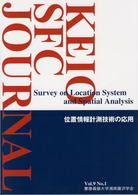基本説明
This volume gives an up-to-date account of various situations of language contact and multilingualism in Europe especially from a historical point of view. Its ten contributions present newly collected data from different parts of the continent.
Full Description
This volume gives an up-to-date account of various situations of language contact and multilingualism in Europe especially from a historical point of view. Its ten contributions present newly collected data from different parts of the continent seen through diverse theoretical perspectives. They show a richness of topics and data that not only reveal numerous historical and sociological facts but also afford considerable insight into possible effects multilingualism and language contact might have on language change. The collection begins its journey through Europe in the British Isles. Then it turns to northern Europe and looks at how multilingualism worked in three towns that are all marked by border and contact situations. The journey continues with linguistic-historical and political-historical visits to Sweden and to Lithuania before the reader is taken to central Europe, where we will deal with the influence of Latin on written German. As far as southern Europe is concerned, the study continues on the Iberian peninsula, where the relationship between Portuguese and Spanish is focused, to be followed by Sardinia and Malta, two islands whose unique geohistorical positions give rise to some consideration of multilingualism in the Mediterranean.
Contents
1. Introduction (by Braunmuller, Kurt); 2. Oceano vox: You never know where a ship comes from: On multilingualism and language-mixing in medieval Britain (by Trotter, David); 3. Language contact and billingualism in Flensburg in the middle of the 19th century (by Fredsted, Elin); 4. Written and spoken languages in Bergen in the Hanse era (by Nesse, Agnete); 5. Vyborg: Free trade in four languages (by Tandefelt, Marika); 6. Dialect and language contacts on the territory of the Grand Duchy of Lithuania from the 15th century until 1939 (by Wiemer, Bjorn); 7. Swedish and Swedish: On the origin of diglossia and social variation in the Swedish language (by Wollin, Lars); 8. Did Latin influence German word order?: Aspects of German-Latin bilingualism in the Late Middle Ages (by Chirita, Diana); 9. From unity to diversity in Romance syntax: Portuguese and Spanish (by Martins, Ana Maria); 10. Sardinian between maintenance and change (by Schjerve-Rindler, Rosita); 11. Language contact and Maltese intonation: Some parallels with other language varieties (by Vella, Alexandra); 12. Index








